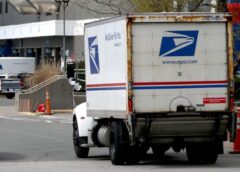Looking to reduce the Postal Service’s use of air transportation, and make feasible slower service for First-Class Mail, Postmaster General Louis DeJoy moved significant quantities of mail onto ground transportation routes for all but the greatest distances.
Now, looking for ways to reduce the reliance on contractors for that service, the PMG is beginning to insource USPS transportation. As reported on August 28 by Government Executive, the initiative also can result in thousands of jobs moving from the private sector into the ranks of the postal union whose favor the PMG continues to curry.
A pilot
The USPS began a pilot program in Oklahoma City late last year, insourcing work once performed by contractors and generating 125 postal jobs. Since then, the initiative has expanded to the Richmond (VA) area, including Charlottesville (VA), according to officials involved and public job postings. Expanding the program into the Richmond area coincided with changes to mail transportation related to converting the existing Richmond P&DC into a Regional Processing and Distribution Center and co-located Local Processing Center.
The article noted that, though the Oklahoma City pilot was planned to last at least six months, it’s still in effect nine months later. Further suggesting permanency, the USPS has signed a memorandum of understanding with the American Postal Workers Union to create a new job category – postal vehicle operator – as part of the initiative.
A USPS spokesperson said the agency is “currently evaluating other locations for expansion” of the pilot program. Not surprisingly, the agency has offered few details about its long-term plans to stakeholders or the public.
Some observers nonetheless expect that insourcing will be included in those areas where the Postal Service is establishing its RPDC/LPC network. Multichannel Merchant recently reported DeJoy is looking to significantly ramp up transportation insourcing by 2025 – a timeline approximating the pace at which the agency will be activating the RPDCs and LPCs.

Benefits and impacts
The overarching premise of DeJoy’s changes to the transportation network seems to have three elements: reducing costs, moving more mail by truck (rather than airplane), and eliminating contracted transportation (by air or truck) as much as possible.
However, though it’s estimated that the USPS has saved $1 billion by cutting mail transportation by air by 90% over the last two years – putting 95% of its mail and packages on the ground – it did so at the expense of service. Conversely, changing from outsourced to insource ground transportation shouldn’t have a service impact but likely will affect costs. The major beneficiary of insourcing ground transportation would be the APWU, a group that DeJoy has been conspicuously trying to assuage since his Plan was issued. Bringing more mail transportation in-house would boost the ranks of its Postal Vehicle Service craft group, about 9,000 APWU-represented employees who now primarily drive routes of fifty miles or less, such as between local facilities.
For longer-haul routes, Government Executive stated that the USPS has over 1,700 contractors operating primarily on highway contract routes of fifty miles or more. The USPS spends almost $5 billion annually on its HCR contracts, nearly four times as much as for its PVS transportation, and those costs grew 18% between 2017 and 2021 as the driver shortage took hold.
Arguably, if the pool of individuals who have or could hold a commercial driver’s license is limited, those individuals’ preferences for private or USPS employment could arise from different motives. Private sector drivers driving some lanes can make more money than USPS drivers and have greater latitude in choosing where they drive, but postal-employed drivers would have stable wages and benefits, fixed schedules, and not have to be away from home overnight.
Observers also note that while current HCR drivers would be candidates for hire by the USPS, the pilot includes training programs for its own employees to help them earn a CDL and thus supply the necessary drivers. Naturally, the latter approach is especially appealing to the union and could offset job losses in other APWU-represented crafts.
The APWU’s craft director for motor vehicle services was quoted as claiming that the insourcing pilot “has the potential for the Postal Service to solve some of the challenges in recruiting, hiring, and retaining.” He “pledged to continue to ‘extol the benefits of having transportation duties performed in-house by postal career operators instead of contractors.’”
Given that it’s often estimated that clerk craft employees working in mail processing or retail service are more expensive than private sector employees doing similar work, it’s unclear whether the move from HCR to PVS drivers will yield the anticipated savings. Moreover, staffing and work assignments for commercial drivers can be adjusted as needed, while USPS staffing and scheduling is largely fixed, meaning that driver complement cannot be easily reduced to match reduced workload, and wages and benefits cannot be adjusted as if they were in a competitive labor market.
Contractors
Obviously, the biggest negative impact of insourcing would be on existing HCR providers. “It’s definitely a cause for concern,” an industry official said of the pilot. “It’s the first time anything like that has happened, to my knowledge.” As Government Executive reported, the USPS had renewed its contracts with impacted vendors just months before launching the insourcing. Oklahoma-based Louis V. Lepak Trucking Company sued the USPS in the US Court of Federal Claims in February, alleging the agency negotiated in bad faith when it renewed the company’s contract just before insourcing the work. The company eventually dropped its suit. For all HCR contractors, the loss of postal work would be a financial blow, but for some of those that exist solely to haul mail, it could be fatal. Many are worried about their future, particularly if they operate shorter routes or have trucks whose drivers aren’t required to hold a CDL. Of course, if the contractor shrinks or fails, its drivers are impacted as well. For DeJoy, who once ran a trucking company, such consequences are not a concern.


